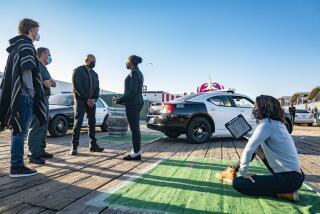Santa Clarita Valley Is Big Hit With Film Makers : Entertainment: ‘Hollywood North’ has been a favorite location for shooting movies since the silent era. Now television has discovered it.
- Share via
A housing tract under construction in Valencia passed for a developing San Fernando Valley neighborhood in the late 1940s in “The Two Jakes,” the sequel to the Academy Award-winning movie “Chinatown.”
The old Saugus train station, built in 1876 and since moved to Newhall, was used for a scene featuring two down-and-out travelers in “The Grifters,” a new Martin Scorsese film now in production. Magic Mountain in Valencia was a destination for “National Lampoon’s Vacation.”
Newhall’s Pico Canyon doubled as part of Africa in “The Color Purple.” The Santa Clara River and its lush vegetation has served as a Vietnam jungle in television’s “China Beach” and “Tour of Duty.” Sand Canyon’s luxurious ranches have been Northern California wine country mansions in the nighttime soap “Falcon Crest.”
The Santa Clarita Valley, with its varied terrain of hills, valleys and housing developments, is so popular as a location for film productions that it is sometimes jokingly called “Hollywood North” or “New Hollywood.”
“I really consider this part of Hollywood,” said Louis Rios, location manager for Newhall Land & Farming Co., which has allowed production companies to film on its 38,000-acre Newhall Ranch for 25 years.
The valley is a kind of “mini-Hollywood,” said Lisa Rawlins of the California Film Commission.
Hollywood has brought its productions to the Santa Clarita Valley since the silent film era when early cowboy stars such as Tom Mix, William S. Hart and Hoot Gibson were drawn there because of its Old West look.
Today, while Los Angeles and other California cities are seeking ways to reverse the number of runaway film operations, the valley, without too much effort, remains a favorite location for feature films and television shows.
Movie makers like the area because of its proximity to Los Angeles, the fact that it is not in a major aircraft flight pattern and its variety of settings. It is especially attractive because most of its locations are within the so-called studio zone, a 30-mile radius centered at La Cienega and Beverly boulevards. Within that area, labor costs are lower because union contracts do not require payment for extra travel costs.
Also, asked location manager Richard Davis, “Where else can you find all that open space?”
For “The Grifters,” he found an area reminiscent of an Arizona of the past.
In the city of Santa Clarita alone, 111 permits were issued for feature films, television series, commercials and student projects during the last fiscal year, which ended June 30, according to Jim Thornton of the Los Angeles County Office of Motion Picture and Television Development, which processes permits for the city.
No statistics are available for the entire valley, but a new Santa Clarita Valley Chamber of Commerce committee formed to encourage more filming in the area estimates that more than 1,000 locations are used there each year.
“If we were a state, we would be third in production behind California and New York,” said Jeff Morton, committee chairman. “That 1,000 figure doesn’t tell you how many days they were filming.”
Morton is manager of Valencia Studios, one of two that opened in the Santa Clarita Valley about three years ago that have attracted more budget-minded producers to the area.
Valencia Studios, owned by David Witt and Robert Thompson, has four buildings and 125,000 square feet of production space. Sets can be built to specification in its converted warehouses.
“Our studio is a converted warehouse with 17 stages either built or under construction,” Morton said.
Lindsey Studios, also in the Valencia Industrial Center, is owned by former location manager John Warren and offers half a dozen constructed sets, including a 1950s diner, hospital interiors, a morgue, a jail and a courtroom.
A third studio, Santa Clarita Studios, is under construction by Herman B. David, studio manager of 20th Century Fox from 1982 to 1987, at an estimated cost of $10 million.
“The industry needs a quiet place away from traffic and aircraft noise,” David said. “The location has lots of advantages. Costs are lower, there’s parking, it’s convenient.”
The chamber committee estimated that filming brings in between $30 million and $40 million a year in sales to valley businesses, such as lumber companies, restaurants, hotels and caterers, and it wants to encourage even more business.
Companies filming on location spend an average of $26,222 a day locally, according to a committee survey.
More to Read
The biggest entertainment stories
Get our big stories about Hollywood, film, television, music, arts, culture and more right in your inbox as soon as they publish.
You may occasionally receive promotional content from the Los Angeles Times.










